Textured Vegetable Protein Market Research, 2035
The global textured vegetable protein market size was valued at $1.5 billion in 2023, and is projected to reach $4.3 billion by 2035, growing at a CAGR of 9.4% from 2024 to 2035. The growth of the textured vegetable protein market is primarily driven by increasing consumer preference for plant-based diets, rising awareness about health benefits, expanding vegan population, and advancements in food processing technologies facilitating texture and flavor enhancement.
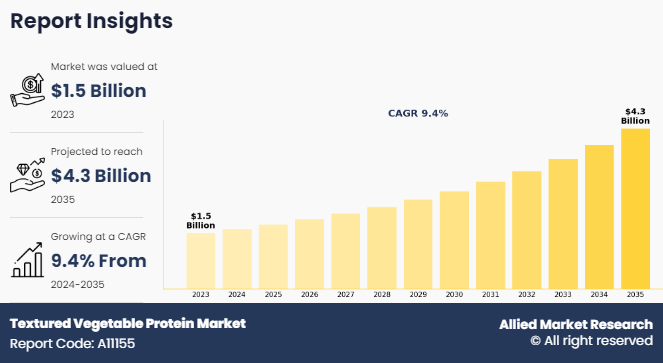
Textured vegetable protein is a plant-based protein specifically derived from pea, soyabean, and wheat. It is a meat substitute and has high protein and fiber content, while having zero fat or cholesterol. The textured vegetable protein is dry and shelf-stable product after processing and is available in different forms including granules, flakes, chunks, and others. Different variants of textured vegetable proteins are available in the market such as textured wheat protein, textured pea protein, textured soy protein and others. Rise in demand for healthy diets boosts the preference for textured vegetable protein majorly textured soy protein in the market. Moreover, the rise in demand for textured vegetable protein from vegetarian consumers looking for protein rich meals drives the growth of the textured vegetable protein market.
Key Takeaways of Textured Vegetable Protein Market Report
- By product type, the textured soy protein segment was the highest revenue contributor to the textured vegetable protein market in 2023.
- As per form, chunks segment was the largest segment in the global textured vegetable protein market during the forecast period.
- Depending on end user, business to consumers segment was the largest segment in 2023.
- Region-wise, Asia-Pacific was the highest revenue contributor in 2023.
Market Dynamics
Rise in demand for plant-based protein is anticipated to drive the growth of textured vegetable protein market. As more consumers adopt vegetarian, vegan, or flexitarian diets for health, environmental, or ethical reasons, the need for alternative protein sources intensifies. Textured vegetable protein, with its high protein content and versatility as a meat substitute, perfectly aligns with this trend. It offers a viable solution for individuals seeking plant-based protein options without compromising on taste or nutritional value. This surge in demand is particularly evident in developed markets where health and sustainability concerns lead to consumer decision-making.
In addition, as the food industry reacts to changing consumer preferences, there is a growing emphasis on adoption of plant-based ingredients into a wide range of products. Textured vegetable protein finds applications in various food categories, including meat analogues, snacks, and bakery items which caters to a wide range of consumer needs and preferences. Its cost-effectiveness compared to animal-derived proteins further enhances its attractiveness to food manufacturers which drives the adoption of textured vegetable protein in new product formulations. Furthermore, as governments and regulatory bodies increasingly promote plant-based diets and sustainable food production practices, the textured vegetable protein market stands to benefit from supportive policies and incentives contribute to the growth of TVP market.
Health consciousness among consumers surge demand for textured vegetable protein market as there is a growing emphasis on healthier eating habits and lifestyles, individuals are increasingly seeking alternatives to traditional meat products that are high in fat, cholesterol, and calories. Textured vegetable protein offers a compelling solution as it is low in fat, cholesterol-free, and rich in essential nutrients such as protein, fiber, and vitamins. This nutritional profile attracts health-conscious consumers who are looking to reduce their intake of animal-derived proteins and adopt more plant-based options into their diets. Moreover, as research continues to highlight the health benefits related with plant-based diets, including reduced risk of chronic diseases like heart disease and certain cancers, boosts the interest in textured vegetable protein products.
Moreover, as consumers become more informed about the environmental and ethical implications of their food choices, there is a growing awareness of the sustainability of plant-based protein sources like textured vegetable protein. The production of textured vegetable protein requires fewer natural resources such as water and land compared to meat production which makes it a more environmentally friendly option. This resonates with health-conscious consumers who prioritize their own well-being and the health of the planet. Furthermore, the versatility of textured vegetable protein allows for a wide range of culinary applications which enable consumers to enjoy their favorite dishes while making healthier choices. Thus, all these factors contribute to the growth of textured vegetable protein market.
The taste and texture of textured vegetable protein limits the demand for textured vegetable protein market. As, textured vegetable protein serves as a popular meat alternative for vegetarians, vegans, and individuals seeking healthier protein options, its texture and taste often fail to replicate the sensory experience of meat products. Consumers adapted to the familiar texture and flavor of meat find textured vegetable protein lacking in comparison, leading to reluctance in adoption and repeat purchase. Despite efforts to improve formulations and processing techniques, achieving a texture and taste profile that closely resembles meat remains a challenge for manufacturers. This limitation hinders the broader acceptance and mainstream adoption of textured vegetable protein, particularly among consumers who prioritize sensory attributes in their food choices.
In addition, the perception of inferior taste and texture impacts consumer trust and brand loyalty in the textured vegetable protein market. Negative experiences with textured vegetable protein products deter consumers from exploring alternative plant-based protein options, which often lead to slower growth of the market. Furthermore, taste and texture inconsistencies across different textured vegetable protein brands and products contribute to consumer uncertainty and further limits the growth of textured vegetable protein market.
Allergen concerns act as a significant restraint on the demand for textured vegetable protein market. As, soy, a common ingredient in many textured vegetable formulations, is a known allergen for some individuals. As allergen awareness grows among consumers, there is an increasing emphasis on clear and accurate labeling of allergenic ingredients in food products. This presents a challenge for textured vegetable protein manufacturers, as the presence of soy as a primary ingredient limits the market demand of their products, particularly among individuals with soy allergies or sensitivities. The need for prominent allergen labeling deters potential consumers from purchasing textured vegetable protein products which lead to reduced market demand and sales.
Moreover, allergen concerns negatively impact consumer trust and confidence in textured vegetable protein brands. Individuals with soy allergies perceive textured vegetable protein products as potentially unsafe or risky, regardless of the manufacturer's safety protocols and quality assurance measures. Furthermore, this results in decreased brand loyalty and reluctance to purchase textured vegetable protein products, particularly in households with members who have food allergies. Thus, all these factors limit the growth of textured vegetable protein market.
The expansion of vegan and vegetarian markets presents significant opportunities for the textured vegetable protein market. As more consumers embrace plant-based diets for health, environmental, and ethical reasons, the demand for alternative protein sources like textured vegetable protein continues to grow. Vegan and vegetarian consumers represent a substantial and rapidly expanding market segment which drives the demand for meat alternatives that align with their dietary preferences and values. Textured vegetable protein, with its high protein content and versatility as a meat substitute, perfectly caters to the needs of these consumers that offers a convenient and nutritious plant-based protein option.
Moreover, the increasing availability of vegan and vegetarian options in retail stores, restaurants, and foodservice establishments provides textured vegetable protein manufacturers with opportunities to expand their market reach. As vegan and vegetarian menus become more mainstream, there is a growing demand for plant-based protein ingredients like textured vegetable protein among food manufacturers and chefs who seek innovative and sustainable solutions. Collaborations with foodservice providers and retail chains facilitate the adoption of textured vegetable protein into a wide range of products, including burgers, sausages, meatballs, and ready-to-eat meals which caters to the preferences of vegan and vegetarian consumers while also appealing to flexitarians and individuals looking to reduce their meat consumption. Thus, all these factors present several opportunities for textured vegetable protein market.
Segmental Overview
The textured vegetable protein market is segmented into type, form, end user, and region. By product type, the market is classified into textured soy protein and others. By form, the market is divided into flakes, granules, chunks, and others. By end user, the market is bifurcated into Business to Buisness and Business to Consumer. Region-wise, the market is analyzed across North America (the U.S., Canada, and Mexico), Europe (the UK, Germany, France, Italy, Spain, and the rest of Europe), Asia-Pacific (China, India, Japan, South Korea, and the rest of Asia-Pacific), and Latin America (Brazil, Argentina, Colombia, and rest of Latin America) Middle East of Africa (GCC, South Africa, and rest of MEA).
By Product Type
By product type, the textured soy protein segment dominated the global textured vegetable protein market in 2023 and is anticipated to maintain its dominance during the forecast period. Soy is one of the most widely cultivated and economically significant legumes globally, providing a readily available and cost-effective source for textured protein production. Moreover, soy protein possesses excellent functional properties, including high protein content, desirable texture, and ability to absorb flavors, making it a versatile ingredient for food manufacturers. Textured soy protein is a complete protein, containing all essential amino acids necessary for human health, thus appeals to consumers seeking nutritious meat substitutes. Furthermore, soy's neutral flavor profile allows for easy utilization into various dishes and enables the creation of a wide range of meat analogs, such as burgers, sausages, and nuggets.
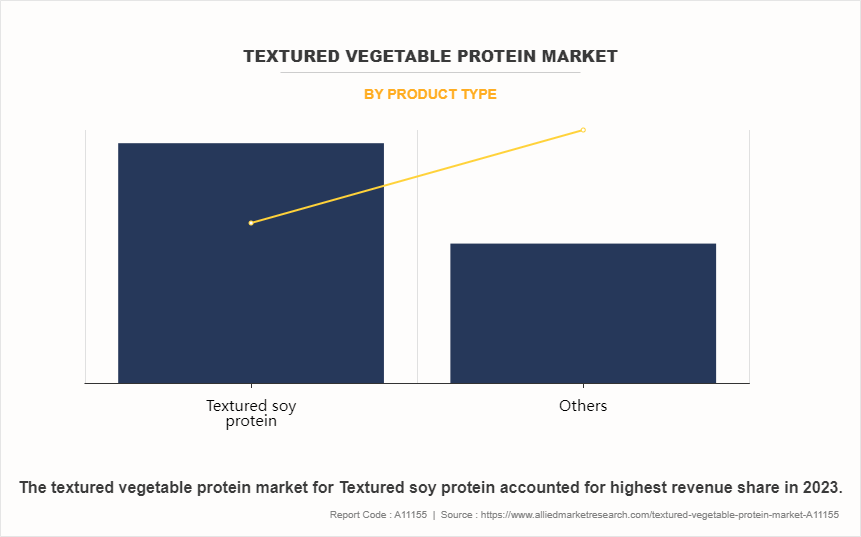
By Form
By form, the chunks segment dominated the global textured vegetable protein market in 2023 and is anticipated to maintain its dominance during the forecast period. Textured vegetable protein chunks offer a meat-like texture and appearance which makes them a popular choice for consumers seeking plant-based alternatives to meat products. This resemblance to meat enhances the acceptability of textured vegetable protein chunks among both vegetarians and flexitarians looking to reduce their meat consumption without sacrificing texture or taste. Textured vegetable protein chunks are highly versatile and are used in a wide range of dishes, including stir-fries, stews, casseroles, and pasta sauces, providing consumers with numerous options for incorporating plant-based protein into their diets. Moreover, textured vegetable protein chunks are convenient to store and prepare and require minimal cooking time and offer a longer shelf life compared to fresh meat alternatives.
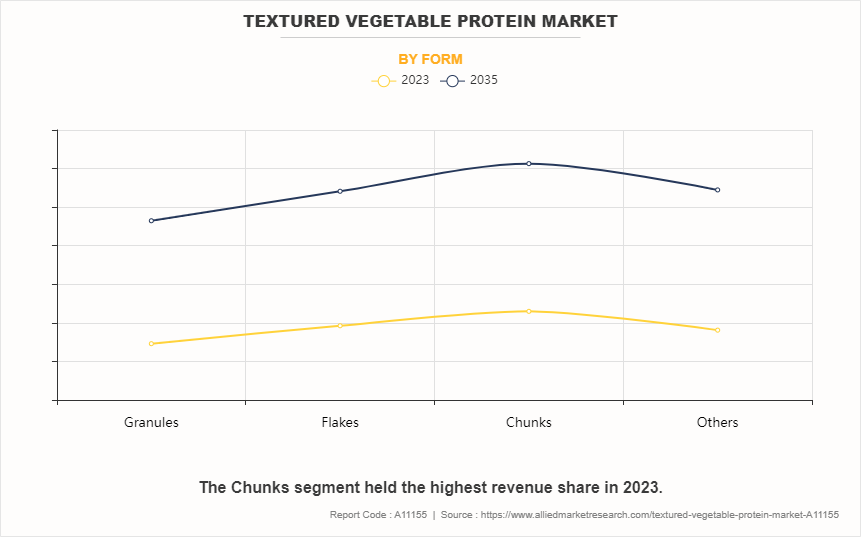
By End User
By end user, the business to consumer segment dominated the global textured vegetable protein market in 2023 and is anticipated to maintain its dominance during the textured vegetable protein market forecast period. Direct interaction with end consumers facilitates designed marketing strategies and brand positioning. B2C channels include supermarkets, online retail platforms, specialty stores, and convenience stores, offering a wide reach to a diverse consumer base. B2C channels provide a platform for brands to communicate directly with health-conscious consumers seeking plant-based alternatives. Moreover, these channels allow for effective product placement, packaging, and labeling to highlight the nutritional benefits and versatility of textured vegetable protein.
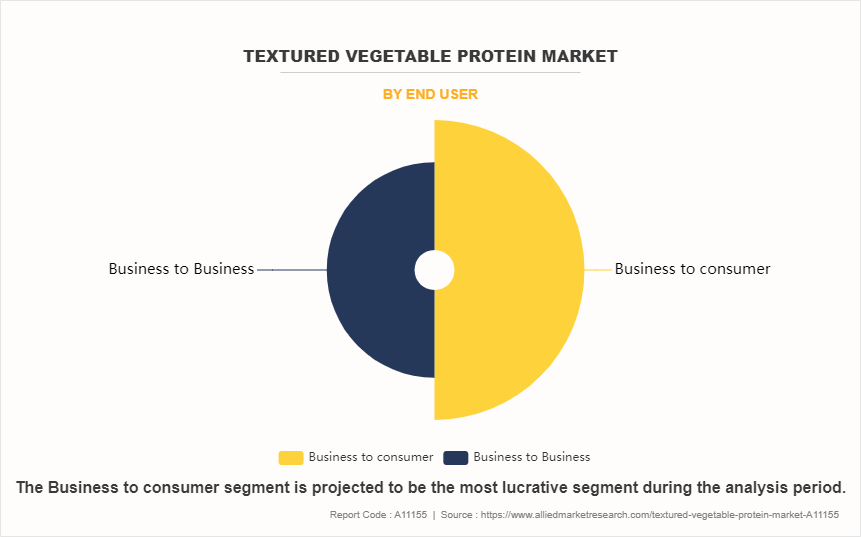
By Region
Region-wise, Asia-Pacific is anticipated to dominate the market with the largest share during the forecast period. Asia-Pacific has a large and diverse population with varying dietary preferences, including a significant vegetarian and vegan population. This demographic shift towards plant-based diets drives the demand for textured vegetable protein as a meat alternative, particularly in countries like China, India, and Japan. In addition, the region is a major hub for soybean cultivation, which serves as a primary raw material for textured vegetable protein production. Moreover, this abundant supply of soybeans ensures a steady and cost-effective source of ingredients for textured vegetable protein manufacturers which contributes in the growth of textured vegetable protein market in Asia-Pacific region.
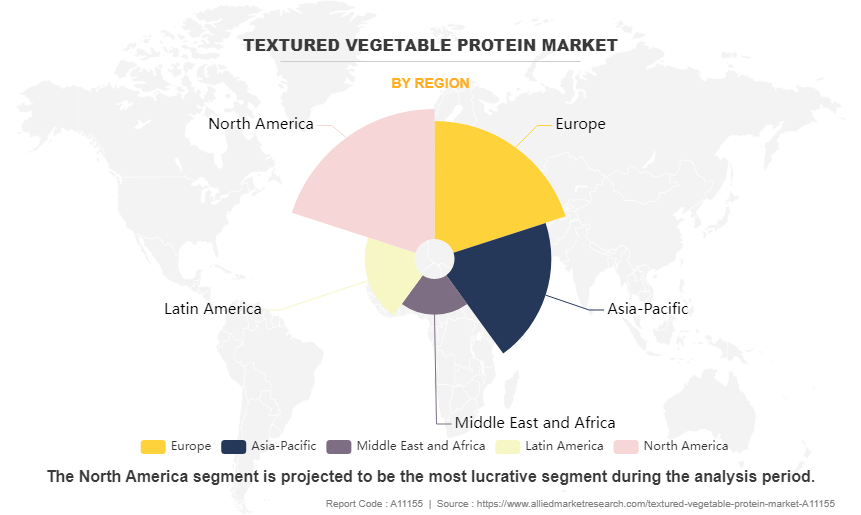
Competitive Analysis
Players operating in the global textured vegetable protein market have adopted various developmental strategies to expand their textured vegetable protein market share, increase profitability, and remain competitive in the market. Leading textured vegetable protein companies profiled in this report include Archer Daniels Midland Company, Axiom Foods, Cargill, Incorporated Inc., Du Pont de Nemours and Company, Foodchem International Corporation, Hung Yang Foods Co., Ltd., Sonic Biochem Extraction Pvt Ltd, Sudzucker Group (Beneo), Victoria Group A.D., and Wilmar International Limited.
Several upcoming brands are vying for market dominance in the expanding textured vegetable protein industry. Smaller, niche firms are more well-known for catering to consumer demands and tastes. Private label brands created by merchants and e-commerce platforms are another aspect of the competitive market. While they provide more affordable options, they have different recognition or range of products than well-known companies. An important competition component is innovation in textured vegetable protein products, sourcing, and sustainability policies. Brands that are able to change the tastes of their target market and align with their ethical & environmental values have an advantage over rivals.
Key Benefits For Stakeholders
- This report provides a quantitative analysis of the market segments, current trends, estimations, and dynamics of the textured vegetable protein market analysis from 2023 to 2035 to identify the prevailing textured vegetable protein market opportunities.
- The market research is offered along with information related to key drivers, restraints, and opportunities.
- Porter's five forces analysis highlights the potency of buyers and suppliers to enable stakeholders make profit-oriented business decisions and strengthen their supplier-buyer network.
- In-depth analysis of the textured vegetable protein market segmentation assists to determine the prevailing market opportunities.
- Major countries in each region are mapped according to their revenue contribution to the global market.
- Market player positioning facilitates benchmarking and provides a clear understanding of the present position of the market players.
- The report includes the analysis of the regional as well as global textured vegetable protein market trends, key players, market segments, application areas, and market growth strategies.
Textured Vegetable Protein Market Report Highlights
| Aspects | Details |
| Forecast period | 2023 - 2035 |
| Report Pages | 280 |
| By PRODUCT TYPE |
|
| By END USER |
|
| By FORM |
|
| By Region |
|
| Key Market Players | Cargill Incorporated Inc., Sonic Biochem Extraction Pvt Ltd, Hung Yang Foods Co., Ltd, Wilmar International Limited, Südzucker Group(Beneo), Archer Daniels Midland Company, Du Pont de Nemours and Company, Foodchem International Corporation, Victoria Group A.D. |
Analyst Review
According to CXOs of leading companies, the rise in number of health-conscious consumers across the globe drives the growth of the market. Moreover, the product innovation and surge in demand for organic protein rich products are the factors anticipated to offer growth opportunities for the market during the forecast period. All these factors fuel the increase in sales of the textured vegetable protein market.
The market players have adopted key developmental strategies such as new product launch, business expansion, and partnership to maintain their position in the vegetable textured protein market, in terms of value sales. They also emphasize continuous innovations in their products to maintain a strong foothold in the market and to boost the sales of textured vegetable protein globally. Furthermore, the rise in trend of veganism majorly in Europe and North America drives the market growth. Furthermore, the key manufacturers added that the availability of counterfeit textured vegetable protein and easy availability of its substitutes in the market at competitive price are the factors projected to hamper the growth of the market during the forecast period.
The global textured vegetable protein market size was valued at $1.5 billion in 2023, and is projected to reach $4.3 billion by 2035
The global Textured Vegetable Protein market is projected to grow at a compound annual growth rate of 9.4% from 2024 to 2035 $4.3 billion by 2035
The key players profiled in the reports includes Hung Yang Foods Co., Ltd, Archer Daniels Midland Company, Foodchem International Corporation, Sonic Biochem Extraction Pvt Ltd, Victoria Group A.D., Südzucker Group(Beneo), Du Pont de Nemours and Company, Cargill Incorporated Inc., Wilmar International Limited
Asia-Pacific is anticipated to dominate the market with the largest share during the forecast period.
Rising Demand for Plant-Based Protein, Health Consciousness, Changing Consumer Preferences
Loading Table Of Content...
Loading Research Methodology...



